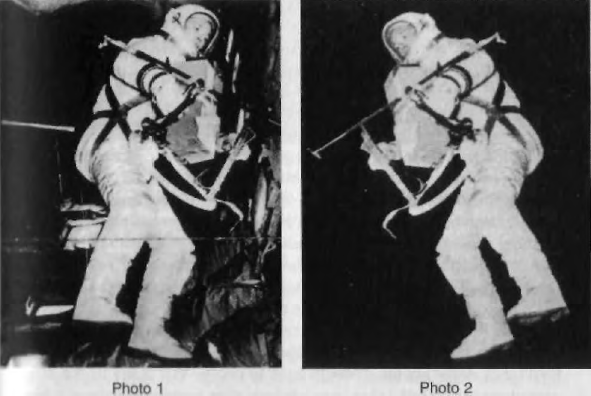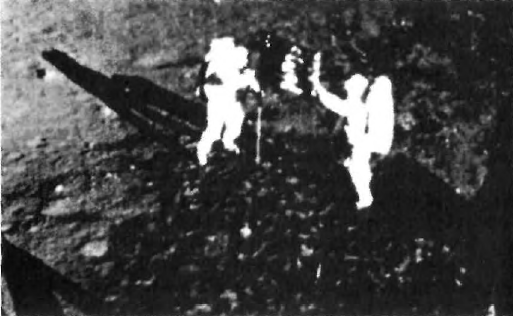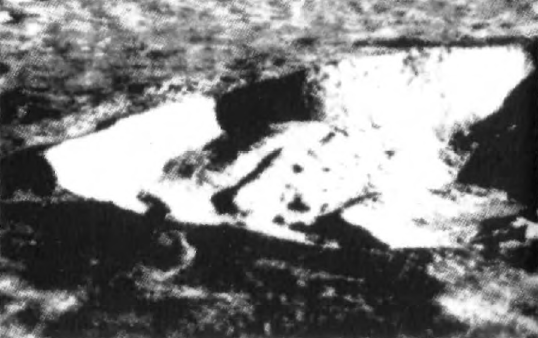|
A
Book Review of NASA Mooned America!
It is also the source of vital [terrestrial] life rhythms. It has been mankind's dream to touch this strange world, for some simply to discover and explore, for others to exploit.
It is now pretty much accepted as common knowledge that the U.S. government's NASA has sent manned craft to the Moon, and that they have landed thereon. But wait, not everybody is buying the official story!
What's up?
Not necessarily in order of appearance, some of these titles are:
All these books are well worth acquiring to broaden one's outlook on this subject. It is a big charge to claim that NASA never went to the Moon, that it was all a fake, yet this man Rene has come up with a large body of information that has to be seriously considered.
He is obviously not writing this book for the fun of
it, I doubt he's making any money at it, and is sure to be scorned
and ridiculed simply for asking good questions which go against the
common belief.
The more one looks at photos of the Apollo landings, the more one begins to wonder. No blast craters exist under the lunar modules (LEMs), no dust arose from their rocket-softened landings, though the lunar rovers toss dust into the air as though there were an atmosphere acting on the particles.
Questions, questions.
One important early faked photo is shown here in sequence (below images).
Rene noticed something fishy about these photos and
reversed #1 and sized it so he could overlay it on #2. They match .
. . they are the same photo . . . and this is official NASA output!
Rene used trigonometry to discover that Aldrin's
person-al source of illumination is at 26.4 degrees of altitude,
while Armstrong's is at 34.9 degrees. The sun was at 13.5 degrees
altitude on the real Moon, so where were these guys? Certainly not
where we have been led to believe. Perhaps a soundstage in the
American desert?
The television footage of the first Moon landing was very poor. While having access to the finest of technology, NASA would not allow a direct feed of the footage, but forced networks and news services to film through an optically enlarged television screen, adding quite a bit of distortion.
During the Apollo 16 lunar lift-off the camera followed the ship up off the surface.
The Spacey Twins. NASA used the same photo twice, perhaps to cut expenses?
Photo 3.
Mutt & Jeff
However, other lunar photos not mentioned by Rene, but appearing in some of the other previously mentioned books, indicate movement and structure on the Moon.
One well known photo (Photo 4), shot from an unmanned orbiter, which has even appeared in National Geographic, shows "boulders" rolling, allegedly from a moonquake. However, basic scrutiny shows that they are rolling up and down hill.
Lesser known photographs show these same "boulders" on other areas of the Moon making identical track marks.
Photo 5 is from National Geographic, September 1973, and was shot by the crew of Apollo 17.
A close-up shot of this same
boulder has appeared in a recent issue of Nexus magazine,
October-November 1995, which shows it to be the same cylindrical
shape with arms as the larger rolling boulder of Photo 4.
Photo 6 is an enlarged section of a
photo of the crater Kepler which appeared in the February 1969
National Geographic. It looks to me like there is an artificial
complex in Kepler. Fred Steckling has a blowup of this structure in
his book.
But let us go on to further discrepancies:
Alan Sheppard, first American to be catapulted up reported seeing no stars, ditto for Virgil Grissom. John Glenn reported seeing some brighter Stars only (and be saw [what NASA claimed were] "fireflies").
To quote some astronauts on the subject:
Professor August Piccard on his high altitude balloon flight circa 1938 (many miles up with special heated suit) said that the sky turned from blue to deep violet to black.
It is said that he claimed the sun disappeared as he got to the higher altitudes, though I have been unable to locate this exact reference.
My own investigations of NASA, circa 1987, revealed people who claimed that the stars could not be seen in space, but that special diffraction gratings were being developed to attempt to see them. This was from the period from Sheppard on to Skylab.
I later spoke with John Bartoe who was up on an early shuttle flight and he laughed at this, said he couldn't believe that anyone in NASA would say that because he was in space and the stars were brighter than they are on Earth! (They must have slipped him a working diffraction grating.)
I called back my contact in NASA and he told me,
I spoke with the man who developed the film for NASA
for twenty-five years and he told me that the astronauts weren't
even sure if they could see the sun, that it may have been the
appearance of the sun on their windows!
The fact that no stars appear on any photos was one of the main pillars of evidence for Bill Kaysing's book. Rene is the source of the astronauts' quotes as above and feels that there must be some serious problem with this selective star-blindness.
As there is no definite answer available to us right
now as to whether or not we can see the stars in space, I would have
to say that we cannot base our conclusion as to the validity of the
Apollo flights on the evidence of the appearance (or nonappearance)
of stars in NASA photos.
At least that is what NASA's line of logic dictates. Apollo 17's LEM sat on the Moon in the direct sun for 75 hours straight. Without massive power and refrigeration units the only way to cool the LEM would have been with the explosive cooling of water. Many tons would have been necessary for that time period.
The
astronauts reported that the LEMs were "too cold to sleep in." How
cold would your closed car be after 75 hours of direct sunlight (or
even 1 hour)?
Conservative calculation of the water necessary to accomplish this, given standard metabolic heat and solar radiation, indicates that the backpacks had to be filled 40 percent with water, allowing room also for an oxygen bottle, carbon dioxide scrubber, dehumidifier, water bladder for the cooling circuit and one for dump water, a heat exchanger, a radio monitoring bodily function, a communications radio with power to reach Houston, and a battery to power all this.
Also, for the cooling to be functioning, the water had to be ejected from the blowhole regularly.
This would have created the effect of a fountain spewing minute crystals of water, quite a tremendous photo opportunity NASA seemed to have missed on tens of thousands of photos.
NASA's own cutaway drawing of the backpack shows a water storage capacity of about .43 gallons, almost enough for 27 minutes of operation at the impossible efficiency of 100 percent.
NASA claims 4 hours of operation.
Then [according to NASA] "they removed their boots, slipped out of the backpacks heavy with life-support equipment that had kept them alive on the Moon, reopened the hatch, and dumped them along with crumpled food packages and filled urine bags onto the surface" (Apollo 11).
There is no airlock on the LEM, how did they open the
door after re-pressurization and dump their suits and garbage
without dying from the supposed vacuum and heat (or was that cold)?
All those astronauts would have received many hundreds or thousands of times the LIFETIME radiation limits for nuclear energy workers.
* ... the radiation was first predicted by Nikola Tesla around the beginning of this century as the result of experimental and theoretical work he had done on electricity in space in general and the electrical charge of the Sun in particular.
He tried then to tell our academic natural philosophers (scientists) that the Sun had a fantastic electrical charge and that it must generate a solar wind. But to no avail. . . .
A Supersonic Transport (SST) must drop altitude when it gets a dosage of 10 millirems, at 100 millirems it must alter its flight plan. 170 millirems is dangerous and almost guarantees cancer in the future.
Subsequent study showed that this belt, or belts,
[begins] in near space about 500 miles out and extends out to over
15,000 miles... Van Allen belt radiation is dependent upon the solar
wind and is said to focus or concentrate that radiation.
The walls of the spacecraft were "paper thin" and the fabric suits had no radiation shielding built in, anyway only very thick lead or a large measure of water (approximately 6 feet of shielding mass) will reduce the radiation of solar flares to anywhere close to safe levels.
How did NASA protect the astronauts against this deadly radiation? The words "Space Radiation" appear extremely rarely, if at all, in books about manned space flights.
Russian scientists told astronomer Bernard Lovell
that they know of no way to shield from radiation outside the Van
Allen radiation belts.
He had become a critic of the Space Program and had expressed unease about the success of actually getting men on the Moon.
The decision to run this test with pure oxygen at pressure was nothing short of moronic—it created a calorimetric bomb which was set off by the astronauts being told to flip switches that caused tiny sparks. Immediately after the test-pad fire, before anyone was notified, government agents raided Grissom's home and took all his personal papers.
When they returned his papers to his widow his
personal diary and all papers containing the word "Apollo" were
missing!
In 1970 Taylor died in a plane crash.
It is a challenge to us researchers to check out his information. Only a small portion of his research appears in this review. Rene has done his homework well and he is an intelligent man. I agree with most of his information, some of his figuring is beyond my technical grasp, and some things I don't agree with, such as his claim that the lunar footprints could only be made in wet soil.
I have made very clear foot-prints in fine, dry desert dust, and I have used them as a guide on returns from the wilderness. I agree that many photos have been faked, that the information doesn't add up, and that NASA will go to great lengths, even murder, to cover up whatever is really happening.
I think, and
have so for a long time, that there is and has been for centuries,
perhaps millennia, intelligent activities occurring on, and perhaps
below, the surface of the Moon. I may be wrong, and I admit that
possibility, but there is a tremendous body of information to back
up my belief.
All of
the authors mentioned in this review can be likened to the six blind
men and the elephant. They all have an important piece of the puzzle
which is being hidden from us. Let's put those pieces together and
work towards a clear picture.
It is possible, given the light of Rene's information on radiation and thermal problems that NASA never went to the Moon. However, there has been quite a bit of activity noticed on the Moon since the discovery of the telescope, and unmanned missions have sent back photos of boulders, obelisks and domes.
Perhaps robot craft were landed and sent the photos necessary to fake the backgrounds of the manned missions, or perhaps there is another answer:
We can speculate that antigravity drives would create a protective field (like a personal Van Allen belt) which would shield those inside the craft from deadly radiation.
If so, then manned missions may well have been undertaken, but for some reason or another NASA still felt the need to fake some of the informational output.
All we can say for sure is that we Never Get a
Straight Answer...!
Back to Vida en Nuestra Galaxia
Back to Contact and Contactees
Back to Astronauts and Apollo's Missions
Back to Extraterrestrial Technology And Reverse Engineering
|



